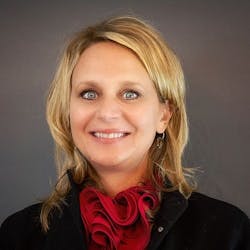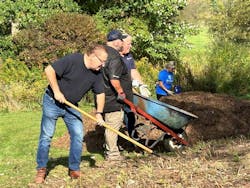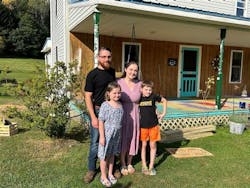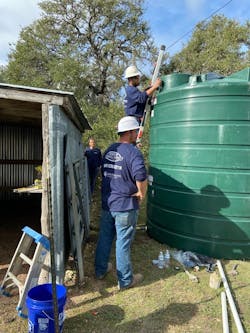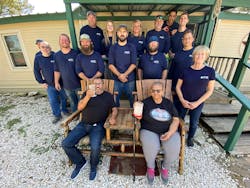Rural America and the Problem of Clean, Accessible Water
According to water accessibility nonprofit DigDeep, there are 2.2 million people in the US without running water inside their homes—no sinks, bathtubs, or toilets. CONTRACTOR's Editor-at-Large John Mesenbrink recently caught up with Xylem’s Austin Alexander, Vice President, Sustainability and Social Impact, and Susan O’Grady, Senior Director of Marketing, to discuss the company’s Watermark program and the real issue of access to clean water, especially in rural areas.
CONTRACTOR: Can you provide a brief description or mission statement for the Xylem Watermark program?
O’Grady: In 2008, Xylem started Xylem Watermark as part of our commitment to social responsibility. Through this program, we are dedicated to providing education and equitable access to safe water and sanitation to support healthy lives and help build resilient communities. We do this through collaboration with nonprofit partners on sustainable development projects and engaging employees and stakeholders in addressing global water challenges. Examples of this include volunteer work, pro-bono expertise, in-kind technology and product donations, and matched monetary contributions. We also provide access to clean drinking water and sanitation, as well as humanitarian emergency response to help communities become more water-secure and sustainable.
CONTRACTOR: Talk about Xylem’s work with the Waterboys on their Hometown H2O program?
O’Grady: We partnered with The Chris Long Foundation’s Waterboys and the Water Well Trust in 2019 to bring further awareness to domestic water issues and bring clean, sustainable water to people and communities in need across the US. The Hometown H2O program brings free access to clean water through the installation of water wells for homeowners who are currently living without dependable water access.
The donations cover all aspects of the project, including necessary equipment, drilling and installation, as well as completion of other home improvement projects. What makes these projects so special is our partnerships with local distributors who act as the boots on the ground during the installation process—it is truly humbling to be a part of such a collaborative venture and come together for the sole purpose of aiding those in need.
So far, we have completed 15 projects in the US and have plans for more. Most recently, we had a project in Parker, Pennsylvania, where a family of four, living in a farmhouse that had been passed down through generations, received a new water well system. As a result, the family no longer relies on friends and neighbors to help them haul water daily from town, a 40-minute round-trip drive—water that is needed for them to complete basic tasks such as cooking, cleaning, showering and doing laundry.
CONTRACTOR: What criteria does the program use to determine which communities will be eligible for a HometownH2O project?
O’Grady: Each Hometown H2O project is a collaborative venture, involving a number of stakeholders within the water community. Our Watermark program partners with The Water Well Trust (WWT), a national nonprofit established by the Water Systems Council, to provide funding for wells benefiting low-income families nationwide in need of safe drinking water or wastewater systems. For Hometown H2O projects, WWT handles the specific applications and verifies applicant qualifications to receive a new donated water well on their property. WWT serves Americans living primarily in rural, unincorporated areas, minority communities that may be difficult to reach, low-income families that do not have access to public water supplies and those who live in areas where the extension of public water service does not make economic sense.
As far as the application process goes, the WWT provides a list of applicants to Waterboys and Xylem Watermark that do not meet all the qualification for the WWT funding. Once a family is selected, our team then coordinates the project, donates supplies, and partners with Xylem channel partners, well driller and contractors to make the project a success at no cost to the homeowner.
CONTRACTOR: To what extent can the current water quality and availability challenges be attributed to the effects of global warming?
Alexander: We are starting to see in earnest the global ongoing and escalating challenges climate change is bringing to the natural water cycle. This can be demonstrated through increased scarcity of freshwater resources in some regions and too much water in other regions. While we often see the most severe and immediate cases on the news, which are important, it is the slow and steady changes to water resources that are making it most challenging to manage water infrastructure and resources. The increasing severity of acute weather-related events in addition to steady baseline adjustments to water resources is a clear indication that water quality and availability are being impacted by the changing climate.
CONTRACTOR: With the growing realization that climate change is a threat to global resources, sustainability is beginning to play a key role in every industry. How can the water industry set an example for everyone else?
Alexander: For me, if any industry is going to lead on sustainability, it should be water. Sustainability is at the core of what it means to monitor, manage and treat water for today and future generations. I believe the water industry has a distinct opportunity to be a leading sector that is addressing climate mitigation through decarbonization efforts, meaningfully address climate adaptation by more efficiently utilizing water resources and finally, continue to support the positive social value clean water brings to our communities. I think the simplest place to start is to continue to do more to tell our story as the water sector—to make sure the world knows how important water availability and quality are to our day-to-day life so that as a society, we don’t fall victim to taking this precious resource for granted.
CONTRACTOR: What links exist between healthy drinking water and socioeconomic circumstances?
O’Grady: You never know how important water is until you don’t have it. When water poverty is in play, people are more likely to be living in economic poverty and experience other quality of life outcomes in turn. In the context of water access, people who cannot maintain personal hygiene because they don’t have clean water to shower, or bathe are often disadvantaged in getting a job. Without a steady income and insurance, regular doctor visits are often postponed or ignored, even when health issues occur. It’s a perpetuating, downward cycle that people, on their own, cannot rise above.
CONTRACTOR: How challenging is it for Americans in rural communities to access clean drinking water?
O’Grady: The reality is that rural households can face a wide range of water infrastructure challenges. For instance, connecting to public water systems is often cost prohibitive and impractical in rural areas where homes are widely dispersed. When you add on
the global issues of rising water costs, aging infrastructure, depleted water supplies and climate change, this only exacerbates the water access challenges that rural communities face.
As a result, families are often forced to source water from rain barrels or other unsanitary means for everyday use; others need to travel long distances to get water for drinking, cooking and bathing; and many more experience sewage backup into their toilets, sinks or bathtubs. These are daily, ongoing struggles Americans in rural areas encounter.
CONTRACTOR: How can water well pumps, and other technology, aid in closing the gap?
O’Grady: Every American has the right to clean and safe drinking water; however, in rural areas, connecting to centralized water systems can be limited and costly. Instead, using individual and small, shared water wells are an economic and cost-effective option for rural communities. Drawing water from a well as opposed to a municipal water system can offer several advantages, from low utility costs to naturally filtered water supply that contains beneficial minerals and nutrients. Water well installations also serve as localized and independent access points for crucial needs such as drinking water and irrigation. The cost savings are tremendous, and the increased accessibility helps to close the economic gap.
However, closing rural America’s water access gap requires various strategies, including the development of innovative technologies. Smart water technology, ranging from intelligent equipment to smart networks to digital solutions, promotes the sustainable management of water and enhances equity in water accessibility, which will in turn help communities secure water access for vulnerable residents.
CONTRACTOR: In 2021, the Infrastructure Investment and Jobs Act was passed, which may result in difficulty getting funds into the right hands. What are you hearing about this, and do you think this is going to have a marked effect on the crisis?
Alexander: The 2021 Infrastructure Investment and Jobs Act is largely considered a success in helping address water infrastructure issues. The Act includes $55 billion in water infrastructure funding, including funds for “small and disadvantaged communities” that can be specifically targeted to rural communities. Although the infrastructure bill is a short-term investment, it is a step in the right direction.
CONTRACTOR: In the Solving Water in Rural America: A Xylem Report, there is a call to action where it says solving water insecurity in rural communities means doing things differently—from technology and policy innovation to creative partnerships that build public awareness of water challenges and solutions. Can you expound on this?
Alexander: The water infrastructure crisis and social inequities related to water access remain largely invisible to the general public. By taking a coordinated policy approach to make water systems more stable, safer, affordable and accessible, lawmakers can efficiently and effectively lay the groundwork for future water security. Major players in the water sector like Xylem, the Water Systems Council and Dig Deep are advocating for these public policy initiatives.
There’s also a need to prioritize the adoption of smart water technologies to help rebuild water infrastructure for the 21st century—and do it in a more affordable way. Improving data availability and visibility can help us make smarter investments into our water infrastructure and improve the longevity and resiliency as climate change continues to impact it.
CONTRACTOR: Can you describe what Xylem is doing in Washington to support clean water advocacy?
Alexander: Xylem partners with government officials and advocacy groups to tackle water issues in the US through public policy initiatives.
We have teamed up with other major players in the water sector, advocating for the inclusion of key water projects in federal recovery spending, and building upon the Infrastructure Investment and Jobs Act (IIJA), which allocated an estimated $55 billion to upgrade water infrastructure and replace lead service lines. This included advocating for funding Tribal communities water infrastructure, resulting in the single largest investment in Tribal infrastructure ever ($13 billion) in the Infrastructure Investment and Jobs Act.
In the spirit of bringing together collaboration across the water sector on these important topics, in June 2022, Xylem launched the Reservoir Center for Water Solutions in Washington to foster collaboration among policy makers, utility associations, foundations and academic institutions to address water-related challenges and build a shared vision for the future of the water sector.
CONTRACTOR: More than two million Americans without access to clean, safe water. How important is collaboration and public awareness in all of this?
Alexander: We often think about water access challenges as something that happens elsewhere, instead of in our own backyard. Global water challenges are immense and daunting, but it’s affecting so many people here in the US where we have the technology and the resources to make sure everyone has access to water.
To make this happen, education is imperative so that people understand how close these water challenges are and how they affect other areas of our lives. Safe drinking water is vital not only to public health, but also economic vitality of rural America. Information and education play an essential role in growing America’s knowledge about where their water comes from and what it takes to deliver reliable water service. To do this, utilities, nonprofits and companies involved in the water sector need to come together and effectively communicate the importance of safe, reliable drinking water through outreach campaigns and community engagement. If we can do this, I believe people would put in their time, resources and expertise toward solving this issue.


